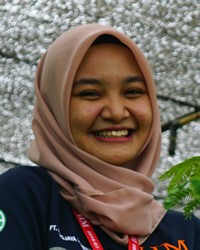Bungku in Indonesia

Photo Source:
Copyrighted © 2025
Azmi Pamungkas - Shutterstock All rights reserved. Used with permission |
Send Joshua Project a map of this people group.
|
| People Name: | Bungku |
| Country: | Indonesia |
| 10/40 Window: | Yes |
| Population: | 41,000 |
| World Population: | 41,000 |
| Primary Language: | Bungku |
| Primary Religion: | Islam |
| Christian Adherents: | 0.01 % |
| Evangelicals: | 0.01 % |
| Scripture: | Translation Started |
| Ministry Resources: | No |
| Jesus Film: | No |
| Audio Recordings: | No |
| People Cluster: | Tukangbesi of Sulawesi |
| Affinity Bloc: | Malay Peoples |
| Progress Level: |
|
Introduction / History
The Bungku (or "To Bungku") live in the districts of North Bungku, Central Bungku, South Bungku and Menui, in the Poso regency of Central Sulawesi province. The immigrant communities in this area use their own languages, such as Bugis, Bajau and Javanese. Many marriages take place between the Bungku people and the immigrant peoples, hence the relationship between the groups is relatively good in this region.
According to history, some of the Bungku ancestors were a group of Bugis who migrated to the area. As a result, Bungku culture is greatly influenced by the Bugis culture of South Sulawesi.
What Are Their Lives Like?
The Bungku make their living as farmers. They grow rice, corn and sweet potatoes as their primary crops and coconuts and sago palm trees as their secondary crops. The Bungku also harvest resin and rattan from the thick jungles in their area. Their land is typically less fertile than other areas of southeast Sulawesi.
Formerly, Bungku communities were segregated into three classes. The heads of the village formed the elite group. The common people formed the middle group. The slaves were the final and lowest group. In the past, the Bungku people lived in remote inland areas and had little contact with outsiders. The building of the Trans-Sulawesi highway had opened the Bungku to other influences.
What Are Their Beliefs?
The majority of Bungku have embraced Islam. Additionally, like many other groups in Indonesia, the Bungku retain older traditional animistic beliefs. For instance, the Bungku still believe in various kinds of spirits and practice various rituals to either pacify or control them. They often ask a dukun (shaman) to intercede with the spirits on their behalf.
What Are Their Needs?
The Bungku manage their plantations with inefficient traditional methods. They need assistance, training and investment (from people who would not exploit them) to learn and implement more efficient methods.
The Bungku also need infrastructure development; the roads that link the regency capital, Poso, with other surrounding plantation areas are very deficient.
Finally, the Bungku in rural areas need access to inexpensive modern medical care and medicine. They currently seek medical care only in emergencies due to financial obstacles and difficulty of access.
Prayer Points
Pray for completion of the Bible translation work that has begun into the Bungku language.
Ask Jesus to appear in dreams and visions to family and village leaders, showing them that he is more than a great prophet.
Ask God to send gospel workers to the Bungku to make disciples and help meet their needs regarding infrastructure, training and medical care.
Pray for a Church Planting Movement among the Bungku that will bless this people and spread to surrounding peoples.